1900 Fashion America 1900 Fashion Trends America
Did you ever notice that the buttons on a shirt are on opposite sides for men and women? Curious to find out how World War Two inverse women's shaving habits? Always thought almost why men stopped wearing high heels? And what makes the fourth finger on our left hand the "band finger"?
These aren't just random happenings or frivolous decisions by fashion magazines. Sometimes, war or other serious considerations influenced how we dress. In fact, there is a fascinating history backside many modernistic mode trends. Read on to get the scoop backside some of our more puzzling manner choices.
10 Why Women Shave Their Legs
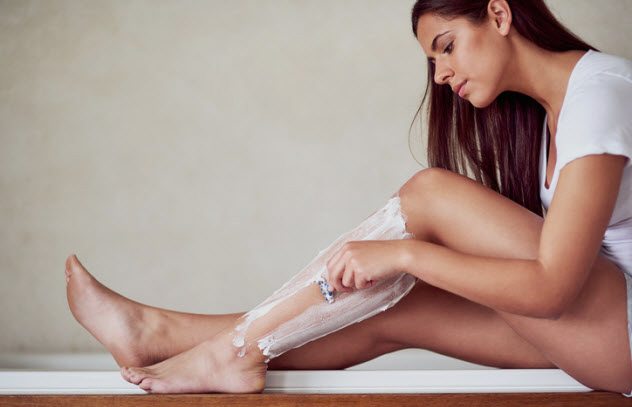
Women take not e'er shaved their legs. Indeed, under the reign of Queen Elizabeth I, who was a trendsetter of her fourth dimension, women weren't expected to remove trunk hair. Instead, the fashion law of that era dictated that women ought to remove eyebrows and hair from their foreheads to make their faces appear longer. But leg pilus? No need to shave.
And so why did that change?
The simple answer is World State of war II. During the state of war, the US experienced a stockings shortage as the government redirected the use of nylon from stockings to war parachutes. For women, the nylon shortage meant having to blank their legs in public. To be deemed socially acceptable, women began to shave their legs. After the war, as skirts became shorter, the trend stuck effectually.[i]
9 Why Girls Wearable Pinkish And Boys Wear Blueish

Nosotros have all been there. At a baby shower, the color of everything—from the tablecloths to the napkins—corresponds to the gender of the baby. Blue is for boys, and pinkish is for girls. But things were not always this way.
For centuries, children younger than 6 mostly wore flowing white dresses co-ordinate to University of Maryland historian Jo B. Paoletti, who wrote Pink and Blue: Telling the Girls From the Boys in America. "White cotton can be bleached," she says, which fabricated it a practical choice.
In the 1900s, colors began to exist used as gender signifiers. Simply the colors did not mean what they practise now. For instance, a June 1918 commodity from a popular manner mag declared:
"The generally accustomed rule is pink for the boys and blue for the girls. The reason is that pinkish, being a more decided and stronger color, is more suitable for the boy, while blue, which is more delicate and dainty, is prettier for the girl."[two]
Still, Paoletti says that these trends weren't peculiarly widespread.
Effectually 1985, that all changed with the ascension of prenatal testing, which allowed parents to determine the gender of the child. As expectant parents learned the sex activity of their babies, they began to store for "daughter" or "male child" merchandise. Retailers noticed and individualized clothing to increment their sales.
For the most part, this trend appears to have stuck. But Paoletti warns that it presents challenges for children who practice not suit to the colors assigned to their gender.
8 Why Women's And Men's Buttons Are On Contrary Sides
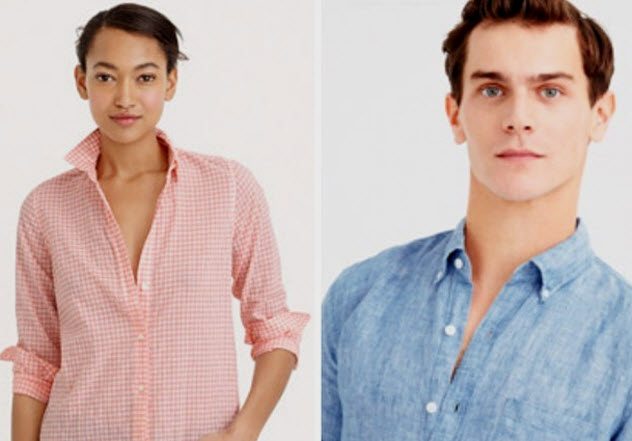
Odds are you ain a button-up shirt. Accept a look at which side the buttons are on. If you're a human being, chances are the buttons are on the correct. If you lot're a adult female, you lot'll likely find your buttons on the left.
In that location's an interesting historical reason for this. Melanie K. Moore, who created women's blouse brand Elizabeth & Clarke, explains: "When buttons were invented in the 13th century, they were, like well-nigh new applied science, very expensive. [ . . . ] Wealthy women back then did not clothes themselves—their lady'due south maid did. Since most people were correct-handed, this made information technology easier for someone standing across from you to button your dress."[3]
As for men's shirts, fashion historian Chloe Chapin traces the fashion quirk to the military. "Access to a weapon . . . practically trumped everything," she says, noting that a firearm tucked inside a shirt would be easier to reach from the dominant side.
vii Why Men Stopped Wearing High Heels

For generations, a pair of high heels has signaled feminine dazzler. But before and then, high heels were a staple in men'south closets.
Elizabeth Semmelhack of the Bata Shoe Museum in Toronto says, "The high heel was worn for centuries throughout the Near East as a grade of riding footwear. [ . . . ] When the soldier stood upwards in his stirrups, the heel helped him to secure his stance so that he could shoot his bow and arrow more effectively."[4]
About the 15th century, when Persian-European cultural exchange heightened, European aristocrats adopted loftier-heeled shoes as a symbol of their wealth. According to Semmelhack, elites have always used impractical wearable to showcase their privileged condition.
Fast-forward to the Enlightenment era, which ostensibly brought with it an appreciation for the applied, and men began to renounce the impractical high heel. But sexism prohibited women from being viewed as rational beings. Semmelhack suggests that the desirability of women was and then seen in terms of irrational style choices similar the loftier heel.
half-dozen Why We Paint Our Nails
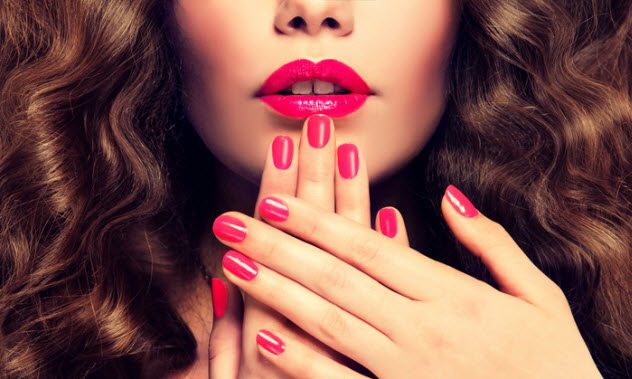
If yous thought the manicure was a new phenomenon, you would exist wrong. Did you know that the world'south oldest manicure set up, made from solid aureate dating to 3200 BC, is over v,000 years old? The aboriginal Babylonians, who created that set, were known to have loved caring for their nails.
Ming Dynasty elites were also fans of painted nails, using a mixture of egg whites, gelatin, and rubber to dye their nails crimson and black. In England, Elizabeth I, a mode icon of her day, was widely admired for her manicured nails and beautiful hands.[5]
Suzanne Shapiro, a researcher at The Costume Plant at the Metropolitan Museum of Fine art in New York, says that long fingernails are impractical for hard labor, so they have tended to signal an elite social status.
Only Shapiro admits that boom trends come and become. During the 1920s and '30s, the French manicure was in. However, during the 1960s, women preferred a more natural look and rarely painted their nails.
5 Why Long Hair Became A Matter For Women

While hair trends have fallen in and out of fashion, one thing across cultures and millennia has remained fairly abiding: the expectation that women would have long pilus. We've seen it from the depiction of a long-haired Aphrodite to St. Paul'due south letter to the Corinthians, in which he wrote, "If a adult female has long hair, it is a glory to her."
Kurt Stenn, author of Hair: A Human History, says that women virtually always have longer hair than men. But why?
According to Stenn, a onetime professor of pathology and dermatology at Yale, hair is highly chatty. Information technology sends messages virtually sexuality, religious beliefs, and power. In particular, he believes that long hair can communicate health and wealth.
"To have long pilus, you lot have to be salubrious," Stenn says. "You have to eat well, accept no diseases, no infectious organisms, you take to have good residual and exercise." He adds, "To have long pilus, y'all have to have your needs in life taken care of, which implies yous take the wealth to practise information technology."[half dozen]
4 Why Some People Sag Their Pants
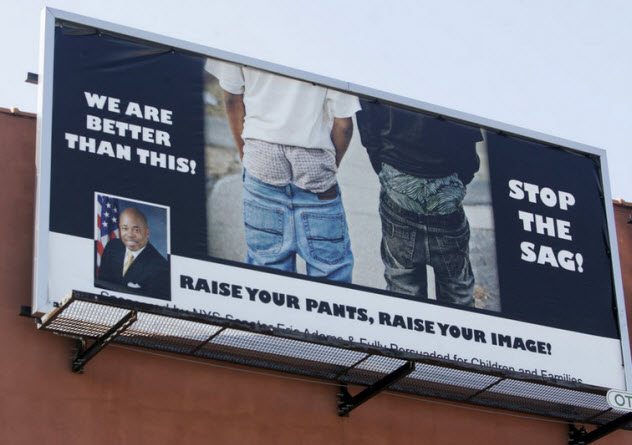
In 2014, the Ocala, Florida, city council passed an ordinance banning the exercise of sagging (wearing one's pants beneath the waistline or, in some cases, the buttocks) on city-endemic holding. An offender would receive a $500 fine or six months in jail.
Similar bans have surfaced from New Bailiwick of jersey to Tennessee. The rationale behind this sort of legislation normally goes something like this: Sagging represents a dangerous lack of self-respect and an cover of gang culture. It is a symbol of moral reject.
Only how did sagging originate?
According to Academy of Massachusetts historian Tanisha C. Ford, the origins of sagging can't exist definitively traced. Only there are ii leading theories. The beginning is that inmates, prohibited from wearing belts in prison, frequently sagged their uniforms. Then they connected the style after returning home. The second theory is that convicts wore their pants depression as a means of letting other prisoners know they were sexually available.[7]
iii Why Nosotros Wear Wedding Bands On The 'Ring Finger'
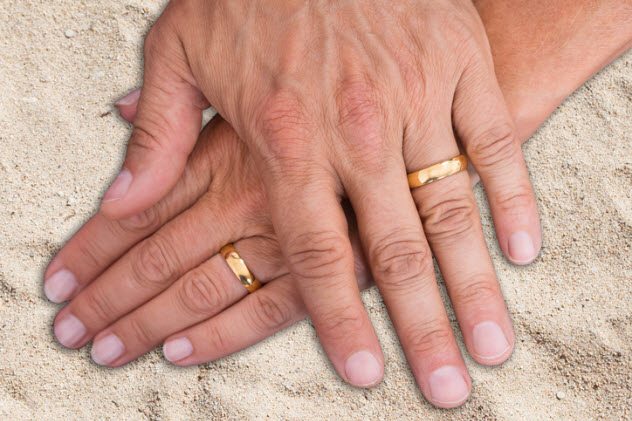
"With this band, I thee wed." The ring is slipped onto the fourth finger of the left hand, and there y'all have it—a helpmate and groom! But have you ever asked yourself why we sideslip our nuptials bands onto the "ring finger"?
The tradition can be traced back to Roman times. The Romans believed that a vein ran directly from the heart to the band finger. They named it the vena amoris ("vein of dear"). Naturally, they thought it'd be fitting to place 1's nuptials band on that finger. Quite romantic!
By the mode, modern science has proven that all fingers have a vein connection to our hearts.[eight]
two Why Men Article of clothing Ties
 Ties. They don't keep united states warm, aren't practical, and are often uncomfortable. So why do men wearable them?
Ties. They don't keep united states warm, aren't practical, and are often uncomfortable. So why do men wearable them?
Most neckwear historians agree that the necktie grew in prominence around the fourth dimension of the Thirty Years' War in the 1600s. To fight the war, Male monarch Louis XIII employed Croatian mercenaries who wore a slice of fabric around their necks.
While these early neckties were largely functional—they tied the tops of their jackets—Rex Louis 13 liked them as sartorial adornments. Indeed, he fabricated these early on neckties mandatory dress for formal gatherings and named them after the Croatian mercenaries: cravate. To this mean solar day, that means necktie in France.
Curiously, Croatia celebrates national Cravat Mean solar day every October 18. In 2003, they commemorated the holiday by tying an 808-meter (2,650 ft) necktie effectually the historic Roman amphitheater in Pula.[nine]
1 Why Women Shave Their Armpits
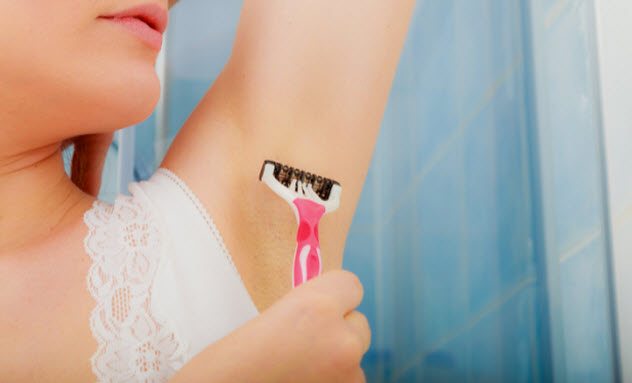
Women and men accept had armpit hair for millennia. Then why do roughly 95 percent of women shave or wax their underarms? Who woke up one day and decided that women with armpit hair are cruddy?
Well, we tin can give thanks a 1915 Harper'due south Bazaar advertisement for that. Before then, women with bushy pits were the norm. Simply the advert told women that modern dancing and sleeveless dresses were the next large affair and that "objectionable hair" was out. The advertising featured a photograph of a young woman in a sleeveless dress. Her artillery were arched over her head, revealing perfectly clear armpits.
Within a few years and after an onslaught of advertisements promoting the tendency, hairless armpits were a thing and natural pilus was something embarrassing. Indeed, a 2013 Arizona State University study measured disgust triggered past women with armpit hair. It yielded responses like: "I think women who don't shave are a little gross."[ten]
Just natural, hairy pits might be making a improvement. One recent report institute that one in 4 millennial women do non shave or wax their pits.
Oscar is a Master of Public Policy student at the University of Oxford. He is originally from Los Angeles, California.
0 Response to "1900 Fashion America 1900 Fashion Trends America"
Post a Comment